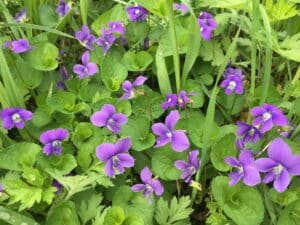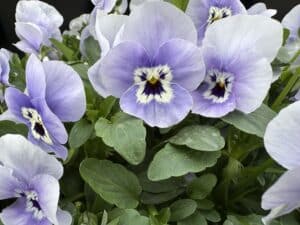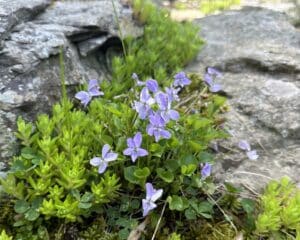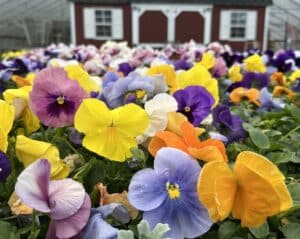Hello, fellow lovers of all things green. In Episode 202 of the Garden Dilemmas Podcast (link below), I share a heartwarming story from my dear friend Vicki Johnson, a garden writer and photographer, about what inspired her to start gardening, which grew into a passion and a career. It stemmed from her mother’s love for gardening and the special delivery of a Swiss Giant Pansey flower. I adore the violet and pansy season, which brings happiness to our lawns, spring gardens, and pots.
Pansies resemble our native Common Blue Violets.
Pansies resemble our native Common Blue Violet (Viola sororia), and they are related—both members of the Viola genus. They are also known as Woolly Blue-Violet or Wood Violet and decorate our lawns in early Spring with heart-shaped leaves and sweet-smelling purple flowers that pollinators crave.

Our native Common Blue Violet is important for early pollinators (Viola sororia).

Pansies resemble our native Common Blue Violet.
I adore how they’ve made their way amongst the patio and the surrounding boulder wall. It’s a shame that some fastidious turf enthusiasts consider them a weed, as a perfect lawn of grass doesn’t support wildlife, including pollinators that support us. It’s one of the lovelies we chat about in Ep 51, Plants for Nooks for Nooks and Crannies, and in my Favorite Plants Between Stepping Stones.
Some say Common Blue Violet can be invasive, but how can something so beautiful (and edible—both the flowers and leaves are high in vitamins A & C) be considered so? Instead, view them as ambitious.
Pansies (Viola × wittrockiana) have larger flowers and come in vibrant colors, with classic blotchy faces contrasting with the rest of their flower petals. Common Blue Violets are smaller, usually blue, although they come in purple and white. I see their little faces, too, perhaps not as distinctive, but I adore how some sport demure freckles.
Pansies and native Common Blue Violets make lovely garden companions— as do Dianthus, Coral Bells (Heuchera,) and the sweet-smelling annual Alyssum.
When and Where to Plant Violets and Pansies
Thriving best in well-drained soil that is slightly acidic or neutral pH, pansies grow 6 to 12 inches tall and wide in full sun to partial shade. Violets are typically 4 to 8 inches tall and are more adaptable to a wide range of soils, thriving in full to part shade.

I adore how the native violets adorn the boulder wall

It’s a shame some turf fanatics consider the native Blue Violets Weeds
In USDA Zone 6 or lower, plant pansies in early Spring, once the ground has thawed, as they prefer temperatures between 45°F and 65°F. I like to add 2-3 inches of leaf mold around the plants to retain moisture and keep the soil cool. While we treat them as annuals here, they may show their little faces for a year or two as they’re considered short-lived perennials.
In warmer climates (Zone 7 and higher,) Pansies are best planted in late summer or early fall when temperatures cool. They will bloom through the winter months, and you can overwinter them by adding a layer of straw. They’ll only live a few years but readily self-seed.
What are Shortlived Perennials versus Biennials?
Short-lived perennials live about 3-5 years as compared to Biennials that complete their lifecycle in two years, such as Queen Anne’s lace (Daucus carota), Black-eyed Susan (Rudbeckia hirta), Foxglove (Digitalis purpurea), and Hollyhocks (Alcea rosea).
In warmer climates (Zone 7 and higher,) Pansies are best planted in late summer or early fall when temperatures cool. They will bloom through the winter months, and you can overwinter them by adding a layer of straw. They’ll only live a few years but readily self-seed.
Bits from Vicki Johnson’s Story titled Waiting for Spring

Race Farm’s lovely assortment of happiness.
Vicki’s Mom would phone each week and share her gardening adventures.
“You wouldn’t believe these pansies. They are so big! The woman who sold them to me said they are called ‘Swiss Giants.’ I wish you could see them. There are yellow ones, white ones, and a purplish-blue one with a yellow center. And they certainly are giant.”
Two days later, Vicki received a package sent to her college dorm. In it— one magnificent flower on a bed of moistened cotton balls.
“When I took it out and held it, it covered the palm of my hand.”
Swiss Giants Blend Pansy Seeds are for sale on the Botanical Interests website, which states: This Swiss heirloom is the parent of most of the pansies we see today and is a 1933 All-America Selections winner.
How fitting that Vicki’s mother’s pansy is a parent of the glorious pansies we adore today.
“All these decades later, there are pansies in my garden every spring, and I can see and almost feel her purplish-blue one with a yellow center resting on the palm of my hand.”
I encourage you to tune in to Vicki’s story, available on the link below and your preferred podcast app. It will warm your heart. I’d love to hear tidbits about your love of gardening or nature and how it began.
Nature is miraculous. Life is miraculous. Seasons are, too — cherish, enjoy, embrace, and live in their presence. We are indeed one world along with nature in this garden of life. Thank you for sharing it with me.
Garden Dilemmas? AskMaryStone@gmail.com and your favorite Podcast App.
There’s more to the story in the Garden Dilemma’s Podcast:
And enjoy Vicki’s Waiting for Spring story in:
More about Vicki Johnson
Related Posts and Podcasts you’ll enjoy:
Ep 202. Pansies Bring Vicki Johnson’s Garden Start
Queen Anne’s Lace Anomaly– Blog Post
Ep18. Walking & Plalking, Queens & Bachelors
Ep 51 Plants for Nooks and Crannies
Favorite Plants Between Steppingstones – Blog Post
Leaf Mold – Better Than Mulch – Blog Post


